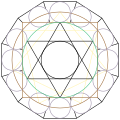Sacred geometry
symbolic and sacred meanings ascibed to certain geometric shapes | |||||
| Upload media | |||||
| Subclass of | |||||
|---|---|---|---|---|---|
| |||||
Sacred geometry is the geometry used in the planning and construction of religious structures such as churches, temples, mosques, religious monuments, altars, church tabernacles; as well as for sacred spaces such as sacred groves, village greens and holy wells, and the creation of religious art. However, in sacred geometry, symbolic and sacred meanings are ascribed to certain geometric shapes, and certain geometric proportions. According to Paul Calter, ...in the ancient world certain numbers had symbolic meaning, aside from their ordinary use for counting or calculating...plane figures, the polygons, triangles, squares, hexagons, and so forth, were related to the numbers (three and the triangle, for example), were thought of in a similar way, and in fact, carried even more emotional baggage than the numbers themselves, because they were visual.[1]
Fringe theory[edit]
As is pointed out by Stephen Skinner in his book Sacred geometry: deciphering the code, it is possible to place a geometric diagram over virtually any image of a natural object or human created structure, and find some lines intersecting the image. If the geometric diagram does not intersect major physical points in the image, the result is what Skinner calls "unanchored geometry." [2] Unanchored geometry, and speculation about the meaning of the geometry itself unsupported by any reliable sources, frequently leads the subject of sacred geometry into the area of New Age fringe theory.
Nevertheless, the concept that God created the universe according to geometric principles is ancient, and the idea is attributed by Plutarch to Plato, who he quotes as saying God forever geometrizes.
-
Rose window
-
Rose window
-
Mandorla
-
Vesica piscis
-
"New Jerusalem" geometric diagram
Notes[edit]
- ↑ dartmouth.edu: Paul Calter, Polygons, Tilings, & Sacred Geometry[1] archive copy at the Wayback Machine
- ↑ Stephen Skinner, Sacred geometry: deciphering the code, p91.[2]





